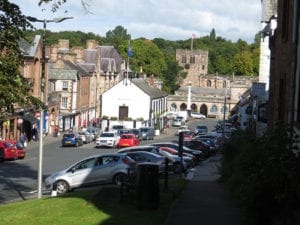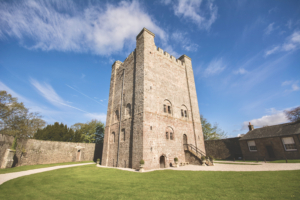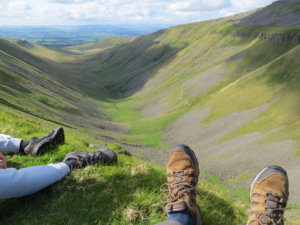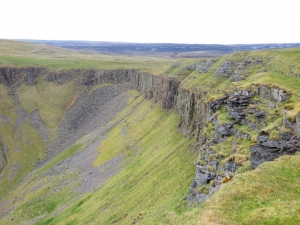The historic market town of Appleby In Westmorland

The name of Appleby comes from the Norse for ‘place with apple trees’ which when you consider the town lies at a strategic crossing of the River Eden makes sense, at least biblically! The town boasts plenty of history both old and new, from the well-preserved Norman Keep at the top of Boroughgate to being the honorary quidditch town of the Appleby Arrows. Apart from the famous horse fair on the first weekend of June the town is rarely busy, and it is a lovely place to stroll either along the river bank or through the town. The town is literally a snapshot of a typical English town centre with everything you could possibly need, but without the big brands, and is still thriving. There is plenty of free parking available, but don’t forget your parking disc (supplied in the cottage).
Heritage
 Appleby is steeped in history from across the ages, predominantly with the castle that overlooks the town from the top of the main thoroughfare of Boroughgate. The mansion house was the preferred residence of Lady Anne Clifford in the 17th Century and her legacy is stamped across the Eden. There are daily tours available in the summer months, and for the first time in 20 years the Norman Keep will be open to visitors from summer 2021. Halfway down the street, past High Cross are Lady Anne’s alms houses, before you reach the Moot Hall and the tourist information centre. Finally, as you pass Low Cross you reach St Lawrence’s Church which originates form the 12thCentury, and houses the tomb of Lady Anne. Appleby is also a stopping point on the famous Settle-Carlisle railway line, considered one of England’s most scenic railway journeys.
Appleby is steeped in history from across the ages, predominantly with the castle that overlooks the town from the top of the main thoroughfare of Boroughgate. The mansion house was the preferred residence of Lady Anne Clifford in the 17th Century and her legacy is stamped across the Eden. There are daily tours available in the summer months, and for the first time in 20 years the Norman Keep will be open to visitors from summer 2021. Halfway down the street, past High Cross are Lady Anne’s alms houses, before you reach the Moot Hall and the tourist information centre. Finally, as you pass Low Cross you reach St Lawrence’s Church which originates form the 12thCentury, and houses the tomb of Lady Anne. Appleby is also a stopping point on the famous Settle-Carlisle railway line, considered one of England’s most scenic railway journeys.
You can download an Appleby Heritage Trail to ensure you don’t miss any of the history.
Shopping

The town is still fortunate for having local shops selling genuine local produce which are well supported by the town residents, including 2 butchers, a bakery and a green grocer. For more general shopping top ups there is a good-sized Co-op and a Spar. Every town needs its selection of gift shops and Appleby has its share including Blue Poppy (see photo), Jak & Co and the Courtyard Gallery. Coupled with a small chemist, a post office and even a traditional sweet shop there should be something for everyone. Finally no visit is complete without a visit to the wonderful Pigney’s, which literally sells everything you could possibly need from a traditional hardware store!
Anyone for Coffee?

There are many great places for food and drink in Appleby. A personal favourite is the Appleby Hub Café which is an artisan-style café with good vegetarian and vegan options, situated next to the town car park. However, there are several others on the high street including Bojangles, Couryard Gallery, the Eden River Café, and the Appleby Tea Room. For a more substantial meal then the Crown and Cushion or the Tufton Arms Hotel are good options, and Ashiana serves good quality Asian cuisine. If takeaway is your thing then you literally have everything available within a short distance of the town centre including fish and chips, pizza, Chinese and Asian options.
And finally
The town has all of those other essentials that can crop up whilst you are away but hopefully don’t. There is a an excellent doctors surgery, 2 dentists, and Boots the chemist as mentioned earlier.
If you even fancy a swim then there is also a public leisure centre, which occupies the site of the old town gas works.

 At one time there were several pubs in the village to support the many miners working in the area. Now there is only one,
At one time there were several pubs in the village to support the many miners working in the area. Now there is only one, 
 Within a short distance of the village green it is possible to see the impact of many of the geological events that have created the scenery of the British Isles. Dufton Pike, Knock Pike and Murton Pike are the result of volcanic activity, with the valley of High Cup a magnificent example of glacial and river erosion. More information of what can be seen can be
Within a short distance of the village green it is possible to see the impact of many of the geological events that have created the scenery of the British Isles. Dufton Pike, Knock Pike and Murton Pike are the result of volcanic activity, with the valley of High Cup a magnificent example of glacial and river erosion. More information of what can be seen can be 

